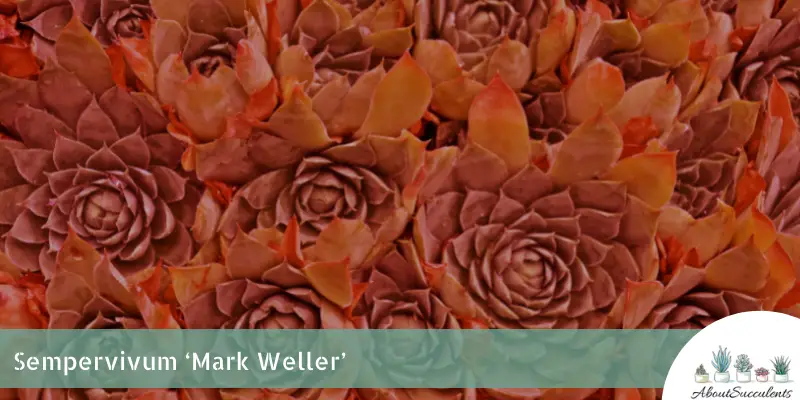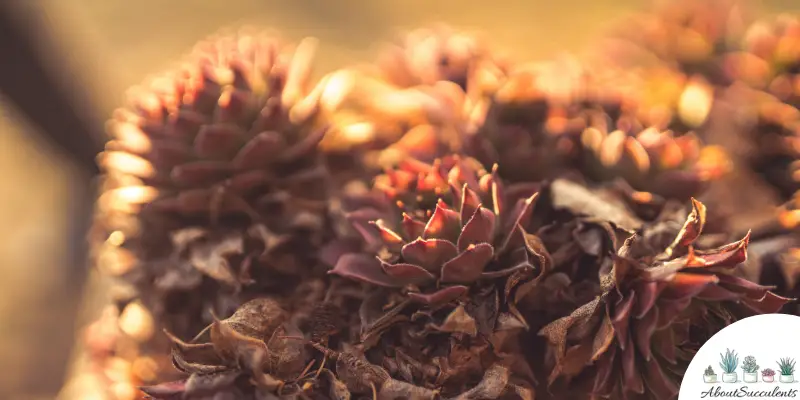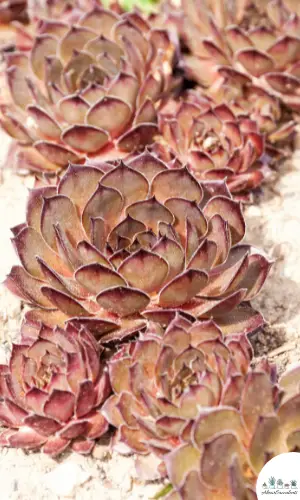
Sempervivum “Mark Weller” is a charming cold-hardy succulent that’s sure to elicit “wows”, wonder, and amazement from your house guests and fellow horticulturists.
Mark Weller is easily distinguished by its long, green leaves that give the succulent the appearance of lilies with pink tips. The leaves form a rosette that measures 5-inches to 6-inches (12.7cm to 15.24cm) wide. Sempervivum itself will only reach a maximum height of 3-inches (7.62cm).
When regularly exposed to direct sunlight, the leaves change color from green to various shades of light pink, gold, or violet in certain seasons.
Typical of Sempervivums, it takes 3 to 4 years of proper care for Mark Weller to produce flowers. When it does, the flowers come out in late spring or early summer and have a pinkish-orange color.
Sempervivum Mark Weller also goes by the name “House Leeks” and “Hens and Chickens”. The latter is because Mark Weller is monocarpic; meaning it produces several offsets before it dies.
The offsets can be pulled out of the plant and be used to propagate more succulents.
Sempervivum Mark Weller is native to Great Britain and belongs to the Crassulaceae family.
General Information
Also known as: Mark Weller, House Leeks, and Hens and Chicks
Plant Family: Crassulaceae
Origin: Great Britain
Height: 3-inches (7.6cm)
Exposure: Partial or full sun for up to 6 hours per day; if you want to get the dusty copper color for the leaves, expose Mark Weller to direct bright sunlight
Water Needs: Drought-tolerant; follow the “Soak and Dry” method or water only when the soil is dry
Soil Type: Succulent soil mix with added gritty materials like coarse sand, pumice, and perlite for better drainage
Soil pH: 6.6 to 7.5
How to Grow and Care for Sempervivum “Mark Weller”

If you live in a region where the temperature can drop as low as -30° F (-34.4° C), Sempervivum Mark Weller is the perfect succulent for you to grow and care for.
Because Mark Weller’s long stems grow outward, this type of succulent is commonly used as ground cover in a rock garden. You can also grow Hens and Chicks in hanging baskets to adorn your outdoor patio.
Sunlight
Sempervivum Mark Weller needs plenty of sunlight for its leaves to attain its gorgeous dusty copper color.
In your outdoor garden, plant Mark Weller in a location that gets at 6 hours of partial to direct sunlight. Avoid the afternoon sun at all costs as the intense rays can damage its much-sought-after leaves.
If you decide to grow Hens and Chicks indoors, you have to be sure that the pot is located near a window that gets 6 hours of partial sunlight every day. Better still, place Mark Weller under a Grow Light for best results.
Although House Leeks can thrive in partial shade, don’t take their durability and adaptability for granted.
If the succulent doesn’t get enough sunlight, its leaves can etiolate or stretch out. Over time, the leaves will wither, weaken, and die.
Watering

Sempervivum Mark Weller can survive dry, arid conditions because it stores plenty of water in its leaves and stems.
The last thing you want to do to your succulent is to give its soil water while there’s still moisture. Extended periods of moisture can lead to fungal growth in the soil.
The roots of Hens and Chicks can rupture and leave the succulent plant vulnerable to fungal infection.
The best approach to watering Mark Weller is the “Soak and Dry” method. Don’t water the soil until you’ve confirmed that it’s 100% dry.
Some horticulturists use an Ergometer to measure the level of moisture in the air. You can gauge the moisture content in the soil by inserting a stick an inch deep. If the stick feels dry to your touch, you can water the soil.
There are 2 rules for watering Sempervivum Mark Weller.
First, only water the soil. Never water the plant. If you water from above, the leaves and stems will retain moisture longer which is something you don’t want.
Second, give the soil a thorough soaking. Remember, that you’ll water only when the soil is bone dry. In the summertime, that might be every seven to 10 days.
During the summer, moisture tends to stay longer in the soil. You might only need to water once a month.
Pot and Soil
You might want to buy an elegant glass bowl to grow Sempervivum Mark Weller in. But when growing succulents, the function is more important than aesthetics.
Choose pots and containers that are made of unglazed ceramic or terracotta for Hens and Chicks. These types of pots allow moisture to leave the soil quickly which reduces the risk of bacterial growth happening.
The pot should be large enough to enable the roots to grow without getting entangled and to support soil aeration. If the base of the plant is 6-inches (15.24cm) get a pot that has a width of 7.2-inches to 8-inches (18.28cm to 20.32cm) Lastly, make sure there’s a drain hole at the bottom of the pot to filter out excess water.
As far as the ideal soil for Mark Weller, this durable succulent can thrive in poor soil conditions. You can plant Hens and Chicks in a commercial succulent mix and add 50% gritty materials such as coarse sand, perlite, and pumice to improve drainage.
How to Propagate Sempervivum “Mark Weller”
You can easily add to your collection of Sempervivum Mark Weller by using its offsets for propagation.
Sure, you can grow the succulent from seeds. But propagating from seeds is complicated because changes in temperature can affect its growth. And propagating from offsets is a fun activity you can do with your kids.
Offsets Method
Step 1: Use a sterilized and sharpened knife to loosen up the offsets from the soil.
Step 2: Gently pull out the offsets.
Step 3: Allow the offsets 2 to 4 days to dry out and grow hardened calluses.
Step 4: Once the calluses are present, plant the offsets in well-draining and gritty succulent soil.
Step 5: Lightly water the soil and place the pot near a window that gets up to 6 hours of partial sunlight every day.
Step 6: If the roots have formed, water the soil only when it has completely dried out.
Frequently Asked Questions
Is Sempervivum “Mark Weller” Toxic To Cats and Dogs?
Sempervivum Mark Weller doesn’t appear in the list of plants that are toxic to cats and dogs found on the website of the American Society for the Prevention of Cruelty to Animals (ASPCA).
Why Is My Sempervivum “Mark Weller” Dying?
If your Sempervivum Mark Weller is dying, there are 2 possible culprits: Overwatering and Pest Infestation.
Don’t worry if your beloved succulent appears weak. Follow our tips below and Hens and Chicks will be happy, healthy, and glowing in no time at all.
Overwatering
If you notice the leaves looking mushy and having yellow-blackish spots, there’s a good possibility that root rotting has taken place and that your plant has been infected by fungi.
The first thing you have to do is to cut off all of the infected sections with a sharpened and sterilized knife. This is done to prevent the fungal infection from spreading.
Next, remove the plant from the soil and cut off all of the roots that have rotted away. Allow Mark Weller to rest for 1-2 days before repotting.
Prepare a new pot with fresh succulent soil. Repot Mark Weller but give the succulent 2-3 days to get used to its new home before watering the soil.
Pest Infestation
Mealybugs are the #1 enemy of Sempervivum Mark Weller. You can’t see them but if you notice white, cotton-like substances on the leaves, that means they’re hiding in your plant.
These white substances can become infectious and contaminate the leaves. The waxy substance can prevent the leaves from receiving the benefits of sunlight. You have to remove them right away with a cotton ball soaked in 70% isopropyl alcohol or with a mild fungicide.
Mealybugs will also drain your succulent of sap which contains many nutrients. Spray House Leeks with diluted neem oil to get rid of mealybugs.
Yes, but it will take 3-4 years of good and proper care for Sempervivum Mark Weller to produce flowers. The blooming period is usually in the late spring to early summer and the flowers have a pinkish-orange color.
Last Updated on June 9, 2022 by Sofia Lara